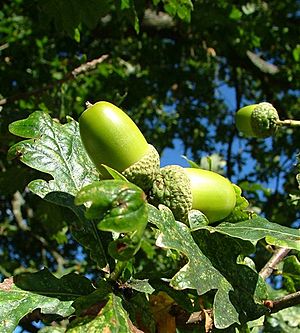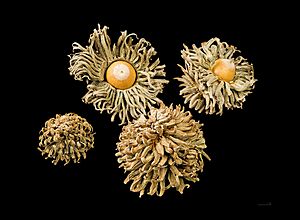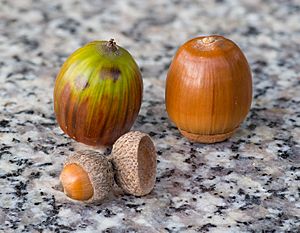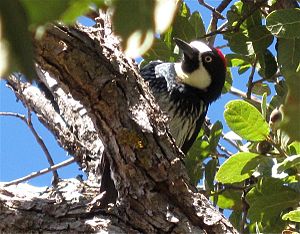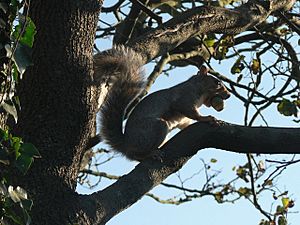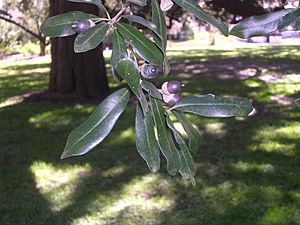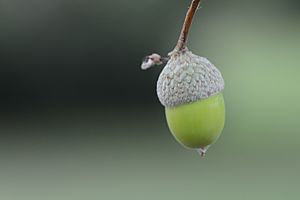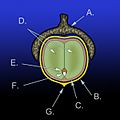Acorn facts for kids
The acorn is the fruit of oak trees. It's a type of nut that usually holds one seed (sometimes two). This seed is protected by a tough, leathery shell and sits in a cup-shaped part called a cupule. Acorns can be anywhere from 1 to 6 centimeters long and 0.8 to 4 centimeters wide.
It takes acorns about 6 to 24 months to grow and become fully ready, depending on the type of oak tree.
Contents
Acorns: A Nutritious Food Source
Acorns are a super important food for many wild animals where oak trees grow. Lots of different creatures love to eat them!
Who Eats Acorns?
- Birds: Jays, pigeons, some ducks, and several kinds of woodpeckers enjoy acorns.
- Small Mammals: Mice, squirrels, and other rodents munch on acorns.
- Large Mammals: Big animals like pigs, bears, and deer eat a lot of acorns. For deer, acorns can make up a quarter of their diet in the fall!
In some big oak forests in southwest Europe, farmers still let their pigs roam free in the fall. The pigs eat the acorns to get fat and healthy. However, it's important to know that acorns can be harmful to some animals, like horses.
Long ago, in some human cultures, acorns were a main part of people's diets. Today, they are usually only a very small food source.
Acorn Nutrients and Tannins
Acorns are full of good stuff! They have lots of protein, carbohydrates, and fats. They also contain important minerals like calcium, phosphorus, and potassium, plus the vitamin niacin. The total food energy in an acorn is similar to other wild foods and nuts.
Acorns also contain bitter substances called tannins. The amount of tannins varies depending on the oak species.
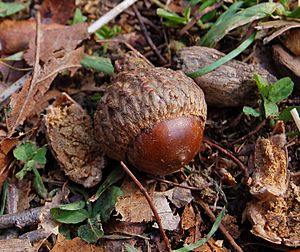
Animals that store acorns, like jays and squirrels, sometimes wait to eat them. They might wait until rain or groundwater has washed away some of the tannins. Other animals eat acorns along with other foods to balance their diet. Many insects, birds, and mammals can handle tannins better than humans.
Some human cultures learned ways to remove tannins from acorns. They used special tools and shared these methods with their children.
Preparing Acorns for Eating
Acorns with lots of tannins are very bitter and can be irritating if eaten raw. This is especially true for acorns from red oak trees. Acorns from white oak trees have fewer tannins, so they taste nutty. Their flavor gets even better if you lightly roast them before grinding.
To remove tannins, you can boil chopped acorns in several changes of water. Keep changing the water until it no longer turns brown.
Because acorn flour has a lot of fat, it can go bad or get mouldy easily. So, it needs to be stored carefully. Acorns are also sometimes used to make massage oil.
How Acorns Spread and Grow
Acorns are too heavy to be carried by the wind. When they fall from the tree, they don't go very far. Because of this, oak trees need help from animals to spread their seeds. This helps the acorns move away from the parent tree and find a good spot to sprout. They need enough water, sunlight, and soil nutrients, ideally at least 20-30 meters away from the mother tree.
Many animals eat acorns right from the tree or off the ground. This doesn't help the oak tree reproduce. However, some animals that eat acorns also help spread them.
Jays and squirrels are good at this! They bury acorns in many different spots to save them for later. This is like planting the acorns in places where they can grow well. Jays and squirrels are very good at remembering where they hid their acorns. But sometimes, an acorn gets lost, or the animal might die before eating all its stored food. A small number of these forgotten acorns manage to sprout and survive, growing into new oak trees.
Acorns sprout at different times, depending on the type of oak. Once an acorn sprouts, it becomes less nutritious. This is because the seed changes into tough, indigestible parts that form the root.
Cultural Meanings of Acorns
Acorns only grow on mature oak trees. Because of this, they often symbolize patience and the reward of hard work over time. For example, an English proverb says, Great oaks from little acorns grow. This means that big, important things can start from small beginnings.
There's a Norse legend that says the god Thor once found shelter from a thunderstorm under an oak tree. This led to a belief that having an acorn on a windowsill can protect a house from being hit by lightning. That's why you might see window blinds decorated with acorns!
In ancient Japan, during the Jomon period, acorns were a very important food. People would collect them, peel them, and soak them in ponds for several days to remove the tannins. Then, they would process the acorns to make acorn cakes.
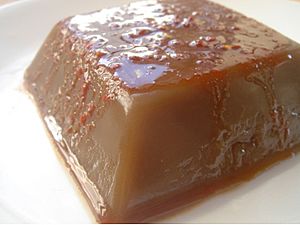
In Korea, people make an edible jelly called dotorimuk from acorns.
Some young people have a fun tradition: they place two acorns in a bowl of water. One acorn represents them, and the other represents someone they like. If the acorns float towards each other, it's believed they will have a future together!
Acorns and Native American Cultures
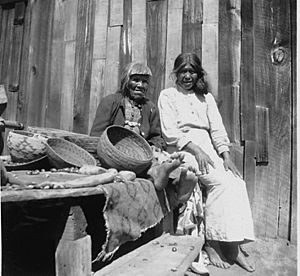
Acorns were a traditional food for many indigenous peoples in North America. They were especially important in California, where many types of oak trees grow. This made acorns a reliable food source.
Unlike many other plant foods, acorns don't need to be eaten or processed right away. They can be stored for a long time. In years when oak trees produced many acorns, Native Americans sometimes gathered enough to store for two years. This was a backup in case there weren't many acorns in the following year.
After drying the acorns in the sun to prevent mould and sprouting, Native American women would take them back to their villages. They stored them in hollow trees or special structures built on poles. This kept the acorns safe from mice and squirrels. These stored acorns could be used whenever needed.
Storing acorns allowed Native American women to process them at convenient times, especially during the winter months when other food was hard to find. Acorns that sprouted in the fall were shelled and ground before those that sprouted in the spring. Because acorns have a lot of fat, stored acorns can sometimes become rancid (go bad) or grow mould.
Native North Americans also actively managed acorn resources. They used controlled fires, which helped the oak trees produce more acorns and made them easier to collect.
Images for kids
-
Diagram of the anatomy of an acorn: A.) Cupule B.) Pericarp (fruit wall) C.) Seed coat (testa) D.) Cotyledons (2) E.) Plumule F.) Radicle G.) Remains of style. Together D., E., and F. make up the embryo.
-
Mortar holes for pounding acorns into flour, Lost Lake, California
See also
 In Spanish: Bellota para niños
In Spanish: Bellota para niños


